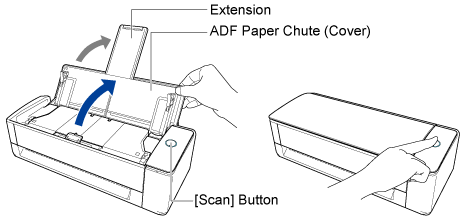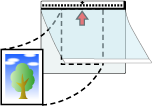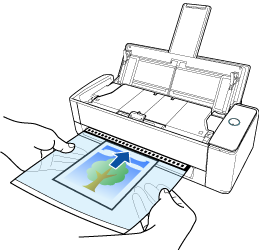Scanning Documents Such as Photographs and Clippings
The optional Carrier Sheet and Photo Carrier Sheet are only available for Return Scan, in which a document is inserted into the manual feeder and scanned.
For details about documents that can be scanned with the Carrier Sheet and Photo Carrier Sheet, refer to here in the ScanSnap Help.
When photographs are scanned with the Carrier Sheet/Photo Carrier Sheet, the document type is not detected as photographs. Therefore, the scanned images may not be saved in a specified cloud storage service. In such a case, tap [Always save to same service] in the [Select cloud storage services] screen to specify a cloud storage service.
The following example procedure shows how to scan with the Photo Carrier Sheet.
- Hold the right side of the ADF paper chute (cover) of the ScanSnap then open it or press the [Scan] button to turn the power on.
Open the ADF paper chute (cover) fully so that the [Scan] button lights up in blue.
When the ADF paper chute (cover) is opened, the extension will rise automatically.

- Check that the [Scan] button on the ScanSnap is lit in purple.
-
Place the document inside the Photo Carrier Sheet.
Open the Photo Carrier Sheet and place the top center of the document against the top center of the Photo Carrier Sheet.

-
Face the scanning side upwards and insert the part of the Photo Carrier Sheet with the black and white pattern straight into the manual feeder.
Make sure that the Photo Carrier Sheet is pulled in and set in the ScanSnap.
 ATTENTION
ATTENTIONThe document comes out from the back of the ScanSnap during the scan.
Leave space (about the length of the Photo Carrier Sheet) at the back of the ScanSnap.
HINTYou can scan a document with the ADF paper chute (cover) closed.
-
Press the [Scan] button on the ScanSnap and scan the document.
The [Scan] button flashes in blue while the scanned image is being sent to the ScanSnap Cloud service.
When the scanned image has been sent, the [Scan] button lights up in purple again.
A new scan history is added to the scan history list of the ScanSnap Cloud application by updating the list. For details about the scan history list, refer to Main Screen.
HINTWhen a scanned image is sent to the ScanSnap Cloud service or saved in a cloud storage service, a push notification is sent to your mobile device.
-
On a cloud storage service that supports the scanned document type, check the scanned image to make sure the document was scanned properly.
Scanned images can be checked on the Detail View Screen of the ScanSnap Cloud application.
HINTIf the scanned image is not saved in a specified cloud storage service, the document type for the scanned document may have been detected incorrectly. In such a case, the scanned image can be transferred to another cloud storage service. For details, refer to Transferring a Scanned Image to Another Cloud Storage Service.
If it is difficult to do so, disable the detection of the document type and specify one cloud storage service. Scanned images will always be saved in the specified cloud storage service, regardless of the document type. For details, refer to [Select cloud storage services] Screen.
In the following cases, place a blank (white) sheet of paper underneath the document when scanning:
Shadows appear around the edges of the scanned image
Black lines appear around the edges of a uniquely shaped cutting

